This edition of Riverwalk Jazz pays tribute to cornetist Bix Beiderbecke and composer Hoagy Carmichael, two pals and like-minded romantics of the Jazz Age whose work remains a landmark in American music. Jim Cullum says, “No doubt there was a cultural revolution in 1920s America —but no one carried picket signs. Personal freedom was the cause, and Jazz was its anthem. Bix and Hoagy were key figures in this new world where all things impossible had suddenly become possible. The music of Bix and Hoagy is full of exuberance and high energy.”
Grade school geography books used to call the Midwest the “bread basket of America” —a place where rich, black earth produced mile after mile of soybeans, corn and wheat. You could see forever across the flat land to a sea of corn stalks waving in the sun. The clean-cut, apple-cheeked Midwest seems an unlikely spot as the birthplace of hardcore, hot jazz musicians. And yet, at the peak of the raucous, roaring Twenties, a consummate pair of jazz artists came of age in the heartland— from Davenport, Iowa cornet giant Bix Beiderbecke, and from Bloomington, Indiana, Hoagy Carmichael, a peerless composer of the iconic jazz standards “Star Dust” and “Georgia on My Mind.”
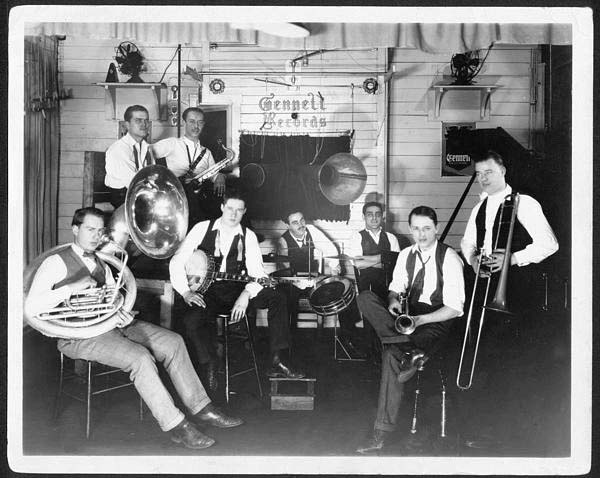
Bix Beiderbecke and the Wolverines, 1924. Photo in public domain.
Bix and Hoagy met one night in 1921 at the Friar’s Inn, a jazz club in Chicago where the New Orleans Rhythm Kings were playing. They crossed paths again and became close friends and collaborators in 1924 when Hoagy booked Bix’s group the Wolverines for a fraternity party at the University of Indiana. The Wolverines were the hottest jazz band around, and Bix and Hoagy were just a couple of kids in their early 20s, having the time of their lives. Hoagy planned a career in law, but Bix had already committed himself to a life in music. Jim Cullum joked, "Hoagy started out as a lawyer, but after meeting Bix Beiderbecke he decided to devote his life to playing the piano and writing songs, making him the only lawyer in US history who ever amounted to anything!"

Bix Beiderbecke. Photo in public domain.
Bix Beiderbecke’s music captivated Hoagy Carmichael as it continues to fascinate musicians to this day. Beiderbecke was a brilliant cornet player, and yet could be so casual in nonchalantly tossing off the most beautiful musical ideas in his solos. In 1928 Bix recorded a classic solo with the Wolverine Orchestra on the tune “Wa Da Da (Everybody’s Doin’ It Now”).” The Jim Cullum Jazz Band performs this classic Twenties tune on our broadcast.
Leon “Bix” Beiderbecke was born on March 10, 1903 in a stately white Victorian house on Grant Avenue in Davenport, Iowa. He fell in love with jazz as a boy, sitting in the family parlor listening to the Victrola. The story goes that he wore out a recording of “Tiger Rag,” playing it over and over again, trying to duplicate the sound of his idol, cornetist Nick LaRocca—leader of the Original Dixieland Jazz Band.

Bix Beiderbecke's childhood home on Grant Avenue, Davenport, Iowa. Photo courtesy Wikimedia.
In the early part of this century, the Mississippi River was a window on the world for the citizens of Davenport, Iowa. Riverboats working the Mississippi from New Orleans to St. Paul, frequently called on Davenport. Stern-wheelers carried passengers, dry goods and jazz bands. On summer evenings, sitting on their front porch, the Beiderbecke family could hear strains of New Orleans jazz floating up to their front porch from riverboats pulled up at the docks below. Bix loved the music; his parents thought it was nothing but noise.

Mississippi Riverboats, early 1900s. Photo in public domain.
On January 26, 1925 Bix had his hometown in mind as he laid down tracks in the Gennett recording studio in Richmond, Indiana, cutting a series of numbers loosely built around blues themes. “Davenport Blues” is Jim Cullum’s personal favorite to come out of that session and he performs it with his band on this broadcast. Jim says, “On that day, Bix recorded a remarkable solo. He played a break that’s a whole tone scale. No one had ever done anything like this in jazz before, but Bix was taken with the avant-garde composers of the day—Ravel and Debussy—who used this technique. Bix was the first to translate into jazz the ideas these composers used in a symphonic setting.”

Early photo of Hoagy Carmichael. Photo courtesy hoagy.com
Hoagy Carmichael grew up with deep affection for his hometown Bloomington, Indiana. He loved its shady backyards and vacant lots where he played baseball with his pals. Music and home life were synonymous to Hoagy. His mother played piano, and it was a wonderfully familiar and constant factor in his young life. His father, always on the lookout for better prospects, moved his family from one town to the next. Hoagy had enough of this nomadic life by the time he was nineteen. Bloomington was a college town, and he returned there, on his own, with plans to finish high school and get into the University— his ticket to a better life.
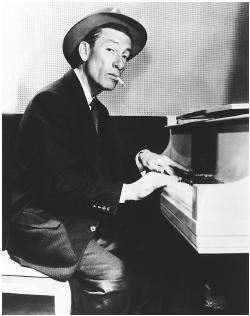
Hoagy Carmichael at the piano. Photo in public domain.
Here, Hoagy Carmichael evokes his early connection to music in Bloomington in this excerpt from his autobiography, Sometimes I Wonder:
“About this time motion pictures began to be popular, and the first film palace in my town, a dusty store front with kitchen chairs instead of theater seats, hired my mother to play for the flickering screen. I can still remember walking with bare feet into the cold parlor, standing beside the upright golden oak piano where my mother practiced her movie music. I remember the long chromatic runs my mother threw off the keys when the cowboys bit the dust. Outside, life on the quiet tree-lined streets moved at a modest pace, not like her train-wreck, girl-tied-to-the-tracks music. Change always upset me. My music is often about things lost to me—simple things like rocking chairs and rainy days, moods and memories of my childhood.”
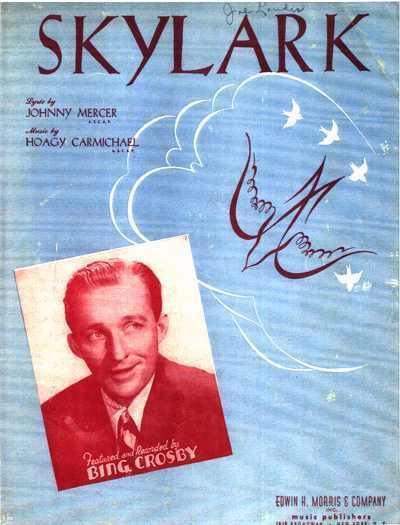
“Skylark” sheet music. Image courtesy Indiana public media.org
Hoagy’s tune “Eventide” is just such a reflective, nostalgic piece. It became a hit for Louis Armstrong in the 1930s, and on this broadcast, Jim Cullum and the Band offer their instrumental rendition of “Eventide.”
By 1930 Bix Beiderbecke’s health and music were in steep decline. In New York, Hoagy’s star was on the rise as a highly successful songwriter in the city’s music publishing area, Tin Pan Alley. Always a great admirer of Bix, Hoagy Carmichael took over musically where Beiderbecke had left off. Hoagy often said that as he sat down to write songs, he often heard the sound of Bix’s horn playing in the back of his mind. One of Carmichael’s most famous tunes, “Skylark,” was originally titled “Bix Licks.” Jim Cullum says, “It’s remarkable to me that every tune Hoagy wrote is such a solid piece of work. He wrote less than a hundred songs in his lifetime, and everyone is a keeper.”
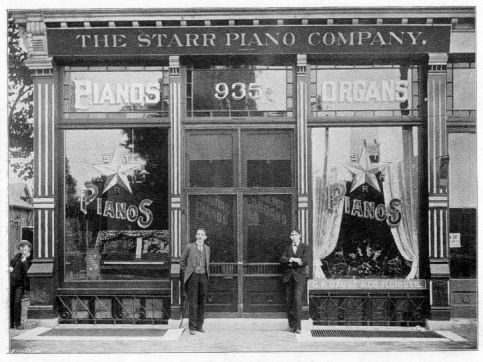
Starr Piano Company Showroom in downtown Chicago, 1896. Photo courtesy waynet.org
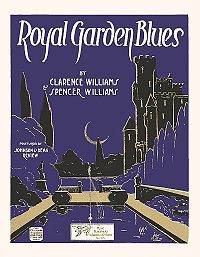
“Royal Garden Blues” sheet music. Image courtesy Wikimedia.
In the late 19th and the early 20th centuries, before the ascendency of the phonograph and network radio broadcasting, the parlor piano was a popular form of home entertainment. In an effort to keep up with the changing times, in 1915 the Starr Piano Company in Richmond, Indiana broke into the recording business. Gennett Records, with its makeshift studio next to the railroad tracks in the back of a piano factory, released many important recordings in jazz history. Bix and Hoagy, King Oliver, Jelly Roll Morton and Louis Armstrong all made key recordings in this sleepy midwestern town. It was June 20, 1924 when Bix went into the Gennett studio for the last time with the Wolverines. They cut three sides that day: the standards “Tiger Rag” and “Royal Garden Blues, and a new number called “I Need Some Pettin,'” performed here by The Jim Cullum Jazz Band. About “Pettin’” Cullum says, “There’s an extended cornet solo on the original recording that’s pure dyed-in-the-wool Bix at his most innovative. Check it out.”
Hoagy Carmichael recalls his friendship with Bix Beiderbecke in another excerpt from Sometimes I Wonder:
“Bix had manners and looked clean cut, even when he was seedy. He was Bix: the real Bix, not the wild drinking mad man of legend. He drank, but not in the “Lost Weekend” kind of drama. His drinking made him thoughtful, not wild. It’s his gentleness that’s lost in the legends—his ability to charm, to hold friends, to make one feel it was possible to be known and needed by another human being. And then there was the music he made—you had to experience it. One day my college band was fooling around when Bix joined us. At the crucial moment, Bix played a break of four notes so perfect in outline, so spacious and exhilarating, so true-toned and resounding that I collapsed on the sofa exhausted with pleasure and excitement.”
Music on this broadcast:

Banu Gibson. Photo courtesy of the artist.
Banu Gibson is a long-time resident of New Orleans, where she leads her own band, the Hot Jazz. Here, Banu joins Jim and the Band on vocals for Hoagy Carmichael favorites “Rockin' Chair” and “Georgia on My Mind,” in arrangements by pianist John Sheridan.
“The Baltimore” composed by Jimmy McHugh, is a dance tune Bix recorded with Frank Trumbauer and His Orchestra in 1927. The Jim Cullum Jazz Band performs it here.
Not only did Bix Beiderbecke make his mark as a pre-eminent jazz soloist of the 1920s, he composed and performed pieces for the piano. With the help of arranger Bill Challis, these pieces were transcribed and gathered together into a collection called the Modern Suite. Some are reminiscent of the Impressionism of American composer Eastwood Lane. On this broadcast, John Sheridan performs the Bix piano piece, “Candlelights.”
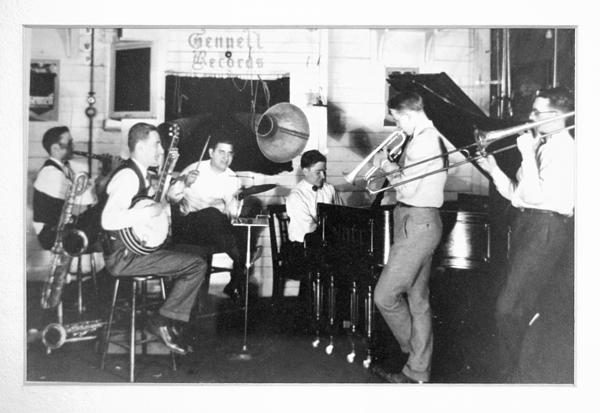
Bix and the Wolverines recording at Gennett Records, February 1924. Photo courtesy indiana.edu
“Riverboat Shuffle” was composed by Hoagy Carmichael in 1924 for a Wolverines recording session on the Gennett label featuring Bix Beiderbecke. Hoagy’s original title for the tune was “Free Wheeling.” Bix re-recorded the tune in 1927 with Frank Trumbauer on the Okeh label. The tune has since become a hot jazz standard.
Photo credit for Home page: Hoagy Carmichael photo in public domain.
Text based on Riverwalk Jazz script by Margaret Moos Pick ©1995


